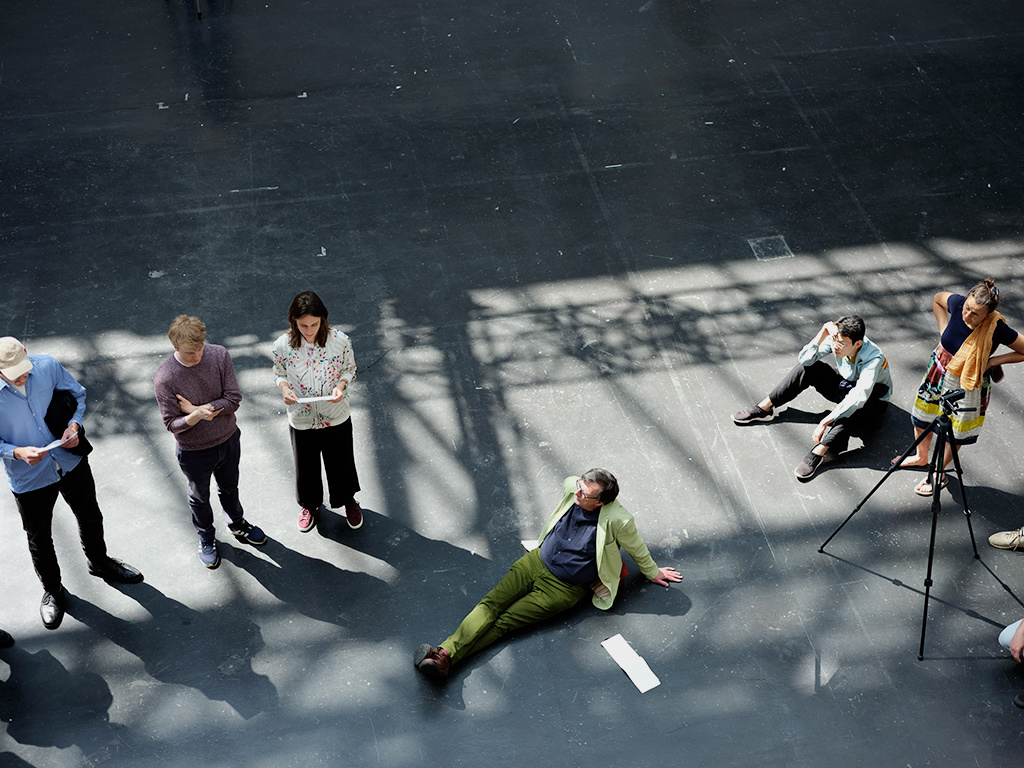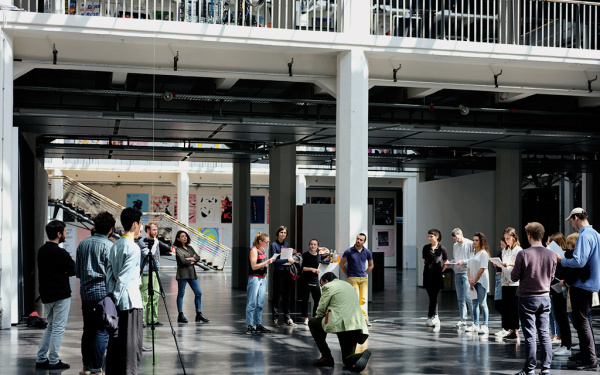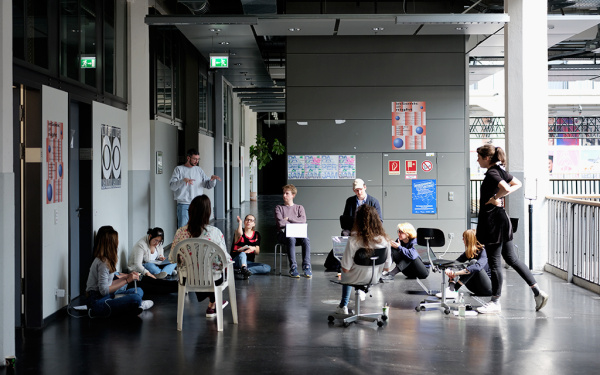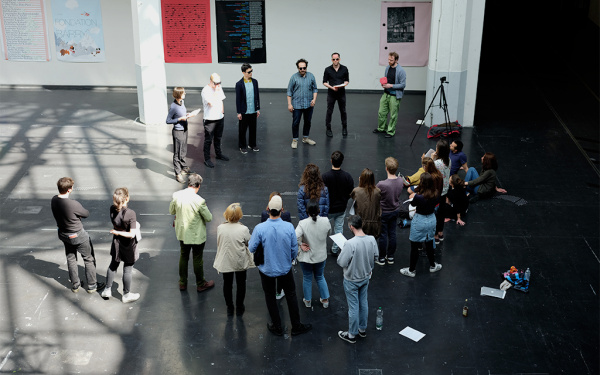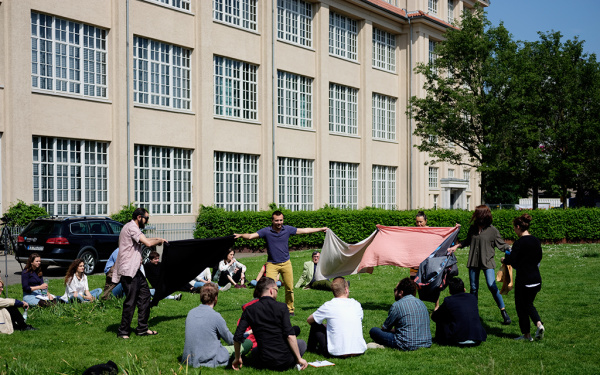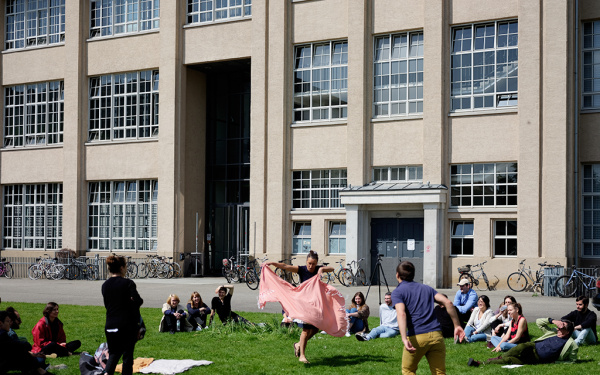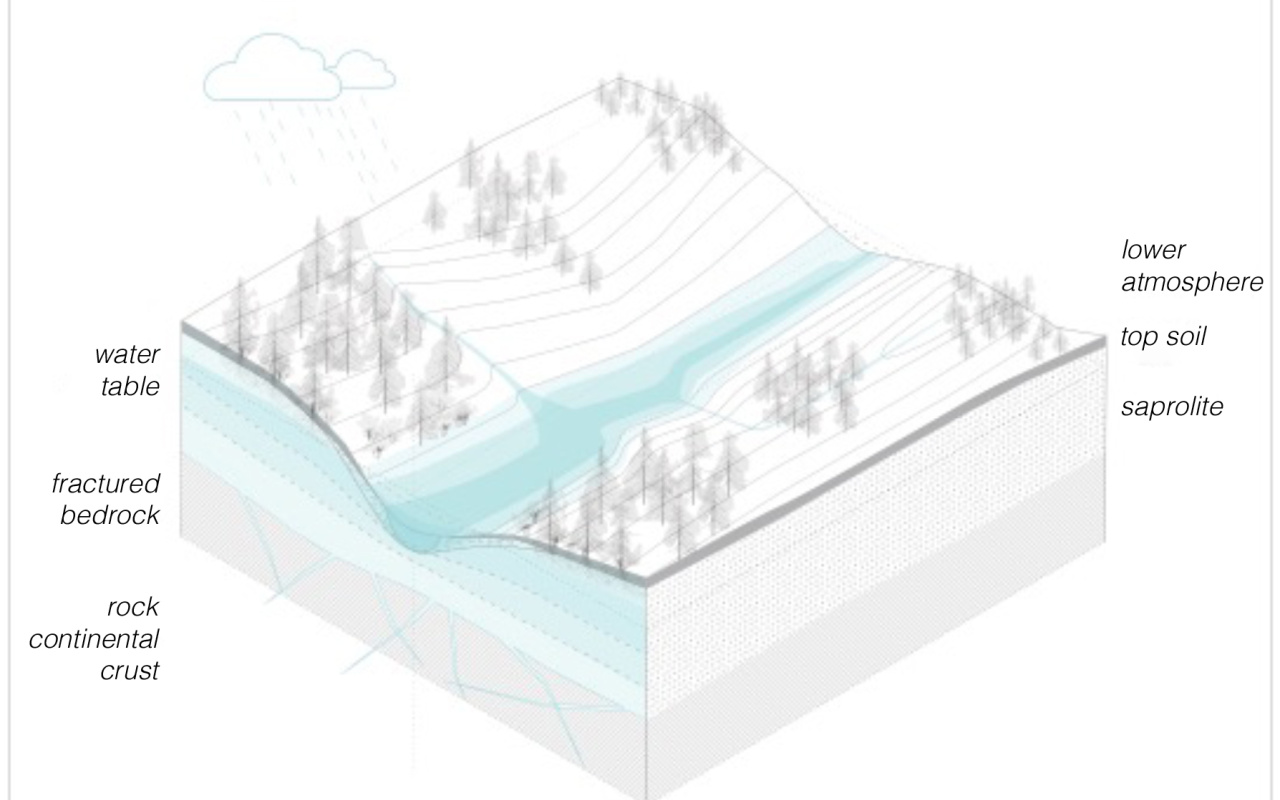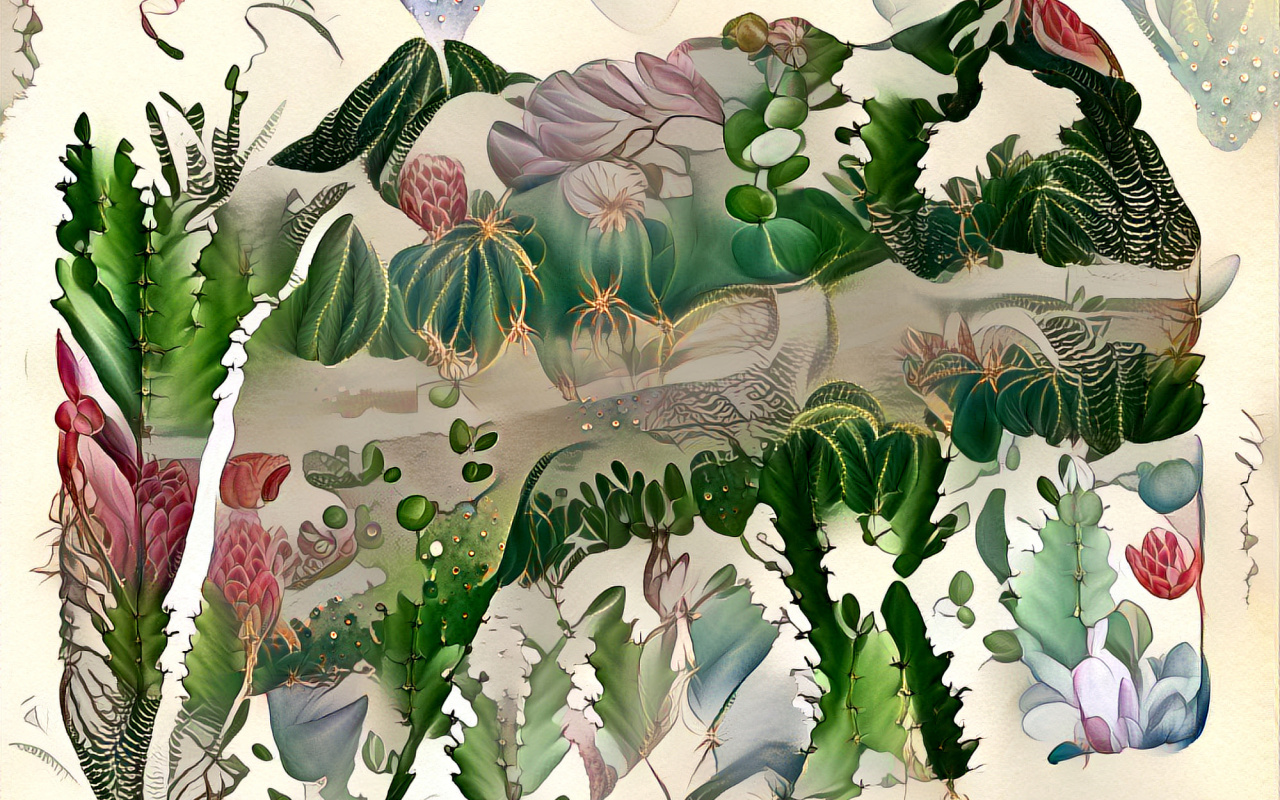A Research Seminar with Bruno Latour
Excursions into the Entanglements of Critical Zones by Martin Guinard-Terrin, Daniel Irrgang and Bettina Korintenberg
Where to land? A seminar for remapping Earth
In his »Down to Earth: Politics in the New Climatic Regime«, Bruno Latour states that »everything will have to be mapped all over again«. The original version of this book (in French) was published in 2017 with the title »Où atterrir?«. The book's French title addresses even more directly the leading question of both the book and the seminar, which Bruno Latour gave at the Karlsruhe University of Arts and Design (HfG): Where will we land?
From January 2018 to November 2019 while he was a guest professor at the HfG Karlsruhe, the French philosopher and sociologist developed an imaginary cartography with which orientation might be possible in the strife-torn relationships between society and politics and the Earth on which we live. He described this as a »new climatic regime«.
In this wider sense, climate is understood as »the relationships of humankind to its material conditions of life«.
Interdisciplinary Work within the Research Network
The seminar brought together students and alumni of the HfG from the areas of theory, design, and the arts with scientists and artists from various regions of the world. In collaboration with curators Martin Guinard-Terrin, Bettina Korintenberg, and Daniel Irrgang, a research associate at the HfG Karlsruhe, Bruno Latour developed approaches and strategies for the exhibition »Critical Zones« together with the seminar participants. In the weeks between the six sessions of the block seminar, the participants worked solo or in groups on research projects for scientific or artistic works, or on participative formats such as workshops and performances, some of which will be presented in the exhibition and/or the exhibition catalogue.
The contributions from the seminar were complemented by others from guests working in science and the arts. For example, Armin Linke, who is known for his investigative and documentary works on the Anthropocene, the proposed name for the current geological age,which is viewed as the period during which human activity has been the dominant influence on climate and the environment on a planetary scale. Armin Linke will be represented in the exhibition with photographic and film works; he also captured in pictures and on film the second seminar session in May 2018, which he has kindly placed at our disposal for this documentation.
The Concept of the »Critical Zone« – The Thin Skin of the Earth
Both the seminar and the exhibition are based on the concept of the »critical zone«. Its origin lies in the interdisciplinary research endeavor of geology, chemistry, and physics, together known as Earth System Science, which also includes social components. Here, the term describes the thin »skin« of planet Earth – the Earth’s permeable near-surface layer, from the tops of the trees to the bottom of the groundwater. It is the boundary layer on which all life has evolved and where rock, soil, water, air, and living organisms interact, regulating the natural habitat and determining the availability of life-sustaining resources. This ever-evolving boundary layer is highly reactive, fragile, and vulnerable – and therefore critical. In the overlapping, highly complex biological systems of the Critical Zone, humankind is but one of many actors, who are dependent on each other in complex ways.
The perspective of the »critical zone«, which describes humanity as deeply embedded in and part of complex geological, chemical, biological, and physical processes, fundamentally calls into question the old dualism of culture and nature which has exerted such a powerful influence in the history of ideas. The scientific-objective, »cultivating« view of phenomena which assumes the distanced interference of humans in nature, is unmasked as an untenable position from outside. An Outside that cannot exist, if humankind is an inseparable part of its environment, which in turn is formed by the heterogeneous interactions of all life forms and their biological and geochemical processes. To Bruno Latour, a vital component in the development of such a perspective, are the pioneering achievements by evolutionary theorist and biologist Lynn Margulis and independent scientist and inventor James Lovelock. Their »Gaia«-theory, which proposes that living organisms interact with their surroundings on Earth to form a synergistic and self-regulating, complex system that maintains and perpetuates the conditions for life on the planet, is an important point of reference for Bruno Latour’s work, and for the seminar. The conference »Next Society – Facing Gaia«, which took place in April 2016 during the exhibition »Reset Modernity!« at the ZKM and engaged with the existential question of how the world’s population will live in the future in the new climatic regime, can be viewed as a prelude to the Critical Zones project in Karlsruhe.
A New Cartography — And Then What?
The question which then arises is how can such a new perspective on our world help us to develop a new relationship to it, in an era fraught with crises (social, political, economic, ecological); a relationship that is not the same abstract, distanced one as that of modernity. In »Down to Earth: Politics in the New Climatic Regime«, Bruno Latour mentions various features of these crises and proposes as a response the potential vector of an »earthly« way of life for humankind. If one follows Latour’s analysis of the current situation, the vector of modernity in the second half of the twentieth century — globalization as the narrative of progress and limitless growth — has had its day. The vector as a wide open path into the future has now become a definite endpoint: our future Earth, with its shrinking land mass and dwindlling resources due to climate change, will not be able to sustain the limitless growth of its human population. The way forward in the direction of globalization, which due to the momentum of modernity is still being pursued, is no longer realistic. But equally, the way back in the direction of the old territory, a return to conservative values like homeland, native soil, and tradition, of which Brexit and America First slogans are symptoms, is not possible in a world of planetary connections. When Bruno Latour asks where can we land, now that the way forward to the globe and the way back to territories are both closed, he sees the move »sideways« as the only possibility. This is the step in the direction of the »terrestrial«, with which we acknowledge a world in which we are embedded and where we maintain complex relations with other human and nonhuman actors — and where respect for the others is imperative for it is indespensable for respecting our own conditions of life. The existential consequences of this entanglement are described by Bruno Latour in »Down to Earth: Politics in the New Climatic Regime«:
Bruno Latour, Down to Earth: Politics in the New Climatic Regime, p. 42.
»If the Terrestrial is no longer the framework for human action, it is because it participates in that action. Space is no longer that of the cartographers, with their latitudinal and longitudinal grids. Space has become an agitated history in which we are participants among others, reacting to other reactions.«
The task of the seminar was to render the space of possibilities that is the terrestrial aethetically and representatively tangible and ultimately experienceable as an exhibition.
Methods Used in the Seminar: Role Plays to Explore Potential for the Terrestrial
Between the Nation State and Earthly Space
The most fruitful methods used in the seminar to explore the speculative vector of the terrestrial were reenactments and performative role plays. For example, Bertolt Brecht’s play »Life of Galileo« was relocated to the future and the main protagonist was replaced by James Lovelock. Through this comparison of the upheavals associated with the establishment of a helopcentric world view ca. 1610 with the turmoil that the terrestrial world view will engender, it was possible to bring out in sharp relief the political and idealistic motives and arguments of the defenders of the »old globe« or »past territories« against the identity of the »new terrestrial way of existence«: Which interests and positions clash with which capacities for action to negotiate the status and validity of new constellations — »cosmologies« — of lifeworlds? Divided up into groups the seminar participants took on the role of inhabitants of the old territory, the nation state, or of the new terrestrial space. First, they had to act out their first confrontation and find a way of communicating their different standpoints to the other side. The main categories, which they had to explain to the other side were the identity of the community (demos), the structure of their deity resp. religious system (theos), and the resulting cosmology (cosmos). Admittedly, these are abstract categories, which are not easy to get across in performative interaction. Nevertheless, the groups came up with some remarkable strategies to get closer to an understanding.
Performative Works and Interventions
In addition to role playing, other performative work held a significant place in the seminar for making it possible to experience the complex relations between nonhuman and human actors in a tangible form. »Micro Worlds«, a participatory intervention which is an approach to the materiality of objects, was developed by performance artist Mira Hirtz and its applicability for an exhibition was tested in the context of the seminar. In the atria of the HfG she marked out an interaction space containing organic and inorganic material, and invited the seminar participants to join in her performance and spontaneously develop rituals whereby the materiality of the particular object as well as the significance of the own relationship towards the object and the space was explored both from a subjective and a relational perspective.
Technology-based Work
In addition to work that was rather performative or a critique of the times, more technology-based work was developed during the course of the seminar. One example is a concept study by Michail Rybakov, an alumnus of the HfG Karlsruhe — one of many the media artist developed during the seminar.
Concept Study by Michail Rybakov
The starting point of this work are the taxonomic color plates published in the works of Ernst Haeckel (1834–1919), who not only coined the term »ecology«, but as a zoologist also increased the awareness of the naturalists who sought to locate their own observer’s position outside of nature – Haeckel’s famous depiction of »The Tree of Life« (1874) famously locates Homo sapiens at the very top of the tree of creation.
Artificial intelligence combined with Ernst Haeckel
Rybakov has processed some of Haeckel’s plates; not with the subjective imagination of an artist who produces an own object, but using the technical imagination of artificial intelligence. Via deep learning algorithms the program was fed with Haeckel’s plates and trained to recognize visual patterns. From this, new images were generated which projected the style of Haeckel’s illustrations onto cross sectional diagrams of the »critical zone«.
The results are image worlds which seem strangely familiar but at the same time fascinatingly alien. They depict bizarre landscapes of folded biological material — like lifeworlds which are a generative part of their own environment and which are characteristic of the »critical zone«.
As these examples of the work done in the seminar show the participants sought to approach the question of where we should land using experimental techniques. Input was provided from talks by Bruno Latour and guest speakers and there was continuous feedback on the projects developed by the participants. This was the framework in which discussions, reenactments, performances, group work, and individual research took place. The only determinant was the goal of an exhibition in May 2020; the seminar itself remained highly explorative and iterative in order to react to current developments.
Looking back, the open structure of the seminar proved a success, if one considers how rapidly public awareness of climate change has progressed since the seminar was held in January 2018 — around six months before Greta Thurnberg’s first SKOLSTREJK FÖR KLIMATET. With the research and exhibition project »Critical Zones« we hope very much to contribute to the most important and crucial debate of our time.
A contribution by Martin Guinard-Terrin, Daniel Irrgang and Bettina Korintenberg.
